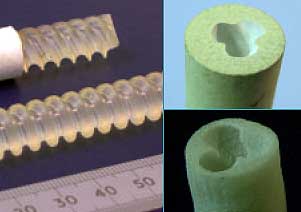For many years, engineers have worked to efficiently filter valuable bio-process products on an industrial, economic scale.
The challenge has been to push rates up without incurring high shear rates and resultant cell lysis, which would cause loss of yield. High shear can destroy delicate and valuable biological materials such as proteins, blood, algae and yeasts, and also brings with it a requirement for higher flow rates, which in turn raises pumping costs.
Inventors at the
The first solution, an insert, could be applied to existing tubular membrane filters (TMF) as an add-on. The second would be a suitable replacement for an existing ceramic block filter element.
The insert helps achieve excellent mixing at low rates of flow, and with a laminar flow pattern, thus minimising cell damage. High filtration fluxes are obtained at much lower feed flow rates than are used in conventional TMF modules. The new technology consists of a moulded insert centrally located in each membrane tube. The insert fits loosely within the tube and takes the form of a coarsely threaded rod with a helical groove of semi-circular cross section.
Complex flow patterns are generated, comprising a helical flow, a leakage flow between the membrane and insert, and strong vortices within the helical channel. The internal helix design has been shown to work for ultrafiltration of protein solutions, with high flux and negligible fouling; separation of plasma from whole blood by microfiltration; and separation of high concentration yeast suspensions.
The technology could offer multiple advantages to biotechnology and bioprocessing companies: it is low cost; it protects sensitive products and enhances yield; it can minimise cell lysis and protein denaturation; it is straightforward to scale-up, and works well at high cell concentrations. A ten-tube microfiltration module is now being used for demonstration purposes.

The second idea relates to membrane filters, particularly of the cross-flow type. The performance of these filters is limited by the efficiency of fluid mixing, i.e. ability to maximise contact of “fresh” unfiltered fluid with the membrane. This development employs a capillary, located within a porous ceramic support material, which is internally ‘helically grooved’. Radial mixing is optimised, ‘membrane’ surface area is increased, and concentration polarisation can be minimised.
Apart from providing a low-shear environment, there are distinct additional practical advantages to this technology: there are no inserts or additional parts; the filters are rigid; it has excellent chemical and thermal stability; thorough sterilisation can be easily carried out; and it can easily be adapted to large-scale units.
The inventions are now the subject of granted patents, and companies interested in developing these systems for commercial applications should contact Isis Innovation.




Glasgow trial explores AR cues for autonomous road safety
They've ploughed into a few vulnerable road users in the past. Making that less likely will make it spectacularly easy to stop the traffic for...